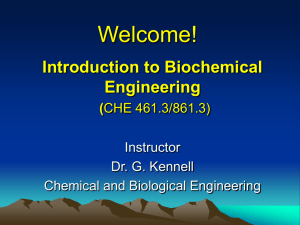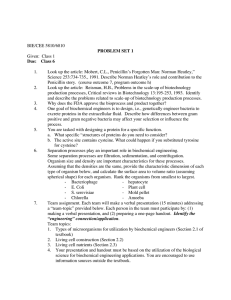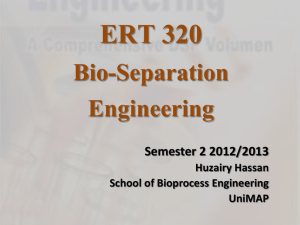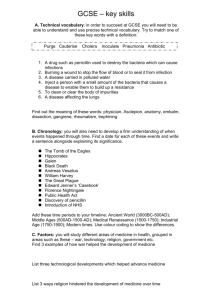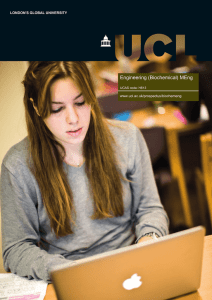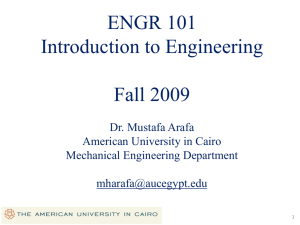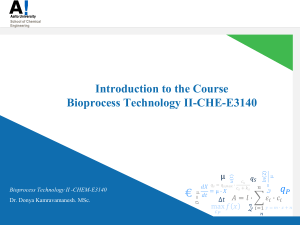CHAPTER 1 WHAT IS A BIOPROCESS ENGINEER? I.
advertisement
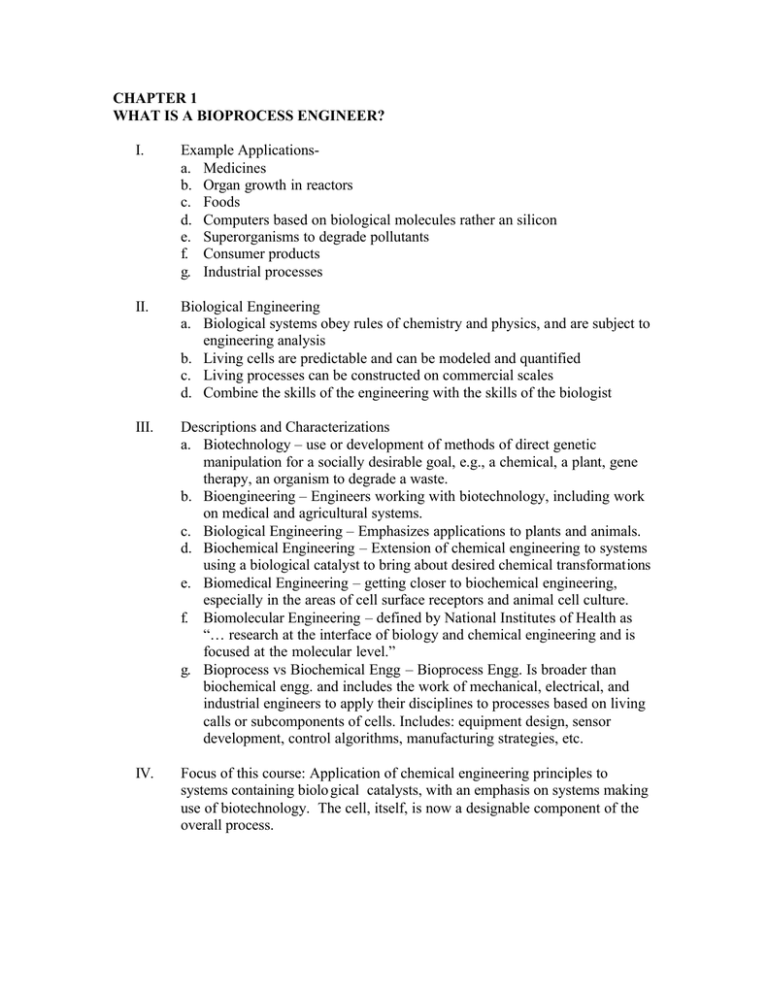
CHAPTER 1 WHAT IS A BIOPROCESS ENGINEER? I. Example Applicationsa. Medicines b. Organ growth in reactors c. Foods d. Computers based on biological molecules rather an silicon e. Superorganisms to degrade pollutants f. Consumer products g. Industrial processes II. Biological Engineering a. Biological systems obey rules of chemistry and physics, and are subject to engineering analysis b. Living cells are predictable and can be modeled and quantified c. Living processes can be constructed on commercial scales d. Combine the skills of the engineering with the skills of the biologist III. Descriptions and Characterizations a. Biotechnology – use or development of methods of direct genetic manipulation for a socially desirable goal, e.g., a chemical, a plant, gene therapy, an organism to degrade a waste. b. Bioengineering – Engineers working with biotechnology, including work on medical and agricultural systems. c. Biological Engineering – Emphasizes applications to plants and animals. d. Biochemical Engineering – Extension of chemical engineering to systems using a biological catalyst to bring about desired chemical transformations e. Biomedical Engineering – getting closer to biochemical engineering, especially in the areas of cell surface receptors and animal cell culture. f. Biomolecular Engineering – defined by National Institutes of Health as “… research at the interface of biology and chemical engineering and is focused at the molecular level.” g. Bioprocess vs Biochemical Engg – Bioprocess Engg. Is broader than biochemical engg. and includes the work of mechanical, electrical, and industrial engineers to apply their disciplines to processes based on living calls or subcomponents of cells. Includes: equipment design, sensor development, control algorithms, manufacturing strategies, etc. IV. Focus of this course: Application of chemical engineering principles to systems containing biolo gical catalysts, with an emphasis on systems making use of biotechnology. The cell, itself, is now a designable component of the overall process. V. Perspectives of Biologist and Engineers a. Fundamental training: i. Biology – qualitative, improvements in experimental/laboratory tools, descriptive models, interpretation of laboratory data from complex systems. Formulation of testable hypotheses, experimental design, and data interpretation. ii. Engineering – emphasis on physical and mathematical sciences, mathematical formulations, quantitative models and approaches to complex systems. Generally unfamiliar with experimental techniques and strategies used by life scientists. b. Life Science Engineer – needs a solid understanding of biology (microbiology, biochemistry, cell biology) and its experimental tools to apply engineering principles to biological systems. VI. Story of Penicillin: How biologists and engineers work together a. 1928, Alexander Fleming, St. mary’s Hospital in London, Staphylococcus aureus. Observations – lack of bacterial growth near contaminated particle. b. Fleming’s genius was to realize that this observation was meaningful and not a failed experiment. Killing organism was Penicillium notatum. c. Norman Heatley – biochemist, play the role of bioprocess engineer. He developed an assay to monitor amount of penicillin made to determine the kinetics of the fermentation. d. During WWII, Howard Florey (of Oxford) approached U.S. companies – Merck, Pfizer, Squibb, and the USDA I Illinois. In 1940 fermentation for the production of a pharmeceutical was an unproved approach (versus chemical synthesis which had more confidence), and penicillin is a fragile and unstable product. e. USDA Northern Reginal research Lab in Peoria, IL, made major contributions, including deve lopment of a medium (corn steep liquorlactose based medium) to increase productivity about 10 fold. New strain, Penicillium chrysogenum, is superior and was used. f. Manufacturing challenges: i. One method was growth on the surface of moist bran. Difficulties in temperature control, sterilization, and equipment size. ii. Surface method – milk bottle containers, “bottle plants.” Difficulties – long growing cycle and labor intensive. iii. Submerged tank process (engineers) – Problems of oxygen supply and heat removal are current problem in antibiotic fermentor design. Pfizer completed the first plant for commercial production of penicillin by submerged fermemtation. iv. Other hurdles in product recovery and purification. v. Merck – realized that people who understood both engineering and biology were NOT available. They assigned an chemical engineer and a microbiologist to work together on each aspect. vi. Progress has involved better understanding of: 1. mold physiology, 2. metabolic pathways 3. penicillin structure 4. methods of mutation and selection 5. process control 6. reactor design vii. The Penicillin process established a paradigm for bioprocess development and biochemical engineering that sill guides the profession. viii. No similar paradigm has emerged from our experience with genetically engineered cells (recombinant DNA). VII. Bioprocess Regulatory Constraints a. U.S. Food and Drug Administration – Three phases for drug approval, takes 15 years from discovery-through-process approval. i. Phase I – safety ii. Phase II – efficacy & side effects iii. Phase III – large scale testing (1000 to 3000 patients) b. GMP – good manufacturing practice. (also GLP – good laboratory practices, and SOP – standard operating procedures). c. FDA approval is for the product AND the process together.
